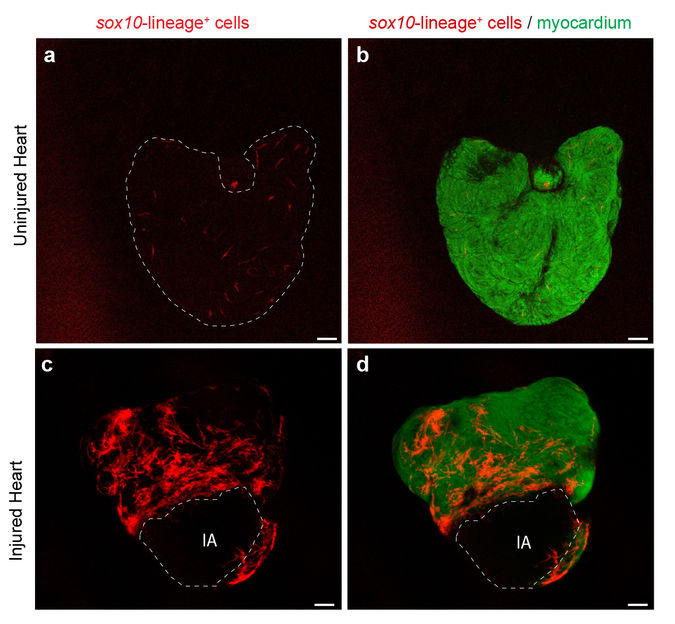Special cells contribute to regenerate the heart in Zebrafish
Advertisement
It is already known that zebrafish can flexibly regenerate their hearts after injury. An international research group led by Prof. Nadia Mercader of the University of Bern now shows that certain heart muscle cells play a central role in this process. The insights gained could be used to initiate a similar repair process in the human heart.

Images of an uninjured zebrafish heart (a,b) and one injured at the tip (IA), (c,d,). sox10-derived cardiomyocytes are shown in red, other myocardial cells in green. The number of the sox10-derived cells increases after injury, and the cells accumulate at the borders of the injury.
© Marcos Sand-Melón
In mammals, including humans, the heart muscle has a very limited capacity to recover after injury. After an acute myocardial infarction, millions of cardiac muscle cells, named cardiomyocytes, die, and are replaced by a scar. Unlike mammals, other vertebrates can recover much better from a cardiac damage. This is the case of some fish, including the zebrafish, a well-established animal model in biomedical research which shares with humans most of its genes.
Zebrafish are extremely well suited to study organ regeneration. After heart injury, zebrafish cardiomyocytes can divide and the scar is replaced by new cardiac muscle. The group of Nadia Mercader from the Institute of Anatomy at the University of Bern has been interested in understanding the cellular mechanisms of heart regeneration during the last 10 years. Now the researchers show that not all cardiomyocytes in the zebrafish heart contribute equally to regenerate the lost muscle, but that there is a specific subset of cardiomyocytes with enhanced regenerative capacity.
"Repair cells" expand more
The researchers teamed up with the Interfaculty Bioinformatics Unit at University of Bern, EMBL (Heidelberg, Germany), CNIC (Madrid, Spain) and the Hospital Universitario La Paz (Madrid, Spain). Using transgenic tools, Marcos Sande-Melón, lead author of the study and colleagues could identify a small subset of cardiomyocytes in the zebrafish heart, marked by sox10 gene expression that expanded more than the rest of myocardial cells in response to injury. These cells differed from the rest of the myocardium also in their gene expression profile, suggesting that they represented a particular cell subset. Furthermore, experimental erasure of this small cell population, impaired heart regeneration. "We were able to identify a specific cell population that is more efficient than all other heart muscle cells during regeneration, and showed that its contribution to repair is essential," says Mercader.
Possible relevance for heart regeneration in humans
In a next step, the authors would like to unravel the role of sox10 in this cell population: "We want to find out whether the absence of such a sox10 cell population in mammals could explain why their heart does not regenerate well," explains Mercader. If this is the case, the researchers believe that this finding could be of great importance in stimulating the repair process in the human heart.
Original publication
Marcos Sande-Melón, Inês J. Marques, María Galardi-Castilla, Xavier Langa, María Pérez-López, Marius-Alexandru Botos, Héctor Sánchez-Iranzo, Gabriela Guzmán-Martínez, David Miguel Ferreira-Francisco, Dinko Pavlinic, Vladimir Benes, Remy Bruggmann, Nadia Mercader; "Adult sox10+ cardiomyocytes contribute to myocardial regeneration in the zebrafish"; Cell Reports; Vol. 29, Issue 4, 22 October 2019.
Marques IJ, Lupi E, Mercader N.; "Model systems for regeneration: zebrafish"; Development; 2019 Sep 20;146(18). pii: dev167692. Review. PubMed PMID: 31540899.
Sanz-Morejón A, García-Redondo AB, Reuter H, Marques IJ, Bates T, Galardi-Castilla M, Große A, Manig S, Langa X, Ernst A, Piragyte I, Botos MA, González-Rosa JM, Ruiz-Ortega M, Briones AM, Salaices M, Englert C, Mercader N.; "Wilms Tumor 1b Expression Defines a Pro-regenerative Macrophage Subtype and Is Required for Organ Regeneration in the Zebrafish"; Cell Rep.: 2019 Jul 30;28(5):1296-1306.e6. PubMed PMID: 31365871; PubMed Central PMCID: PMC6685527.
Sánchez-Iranzo H, Galardi-Castilla M, Sanz-Morejón A, González-Rosa JM, Costa R, Ernst A, Sainz de Aja J, Langa X, Mercader N.; "Transient fibrosis resolves via fibroblast inactivation in the regenerating zebrafish heart"; Proc Natl Acad Sci U S A; 2018 Apr 17;115(16):4188-4193. Epub 2018 Apr 2. PubMed PMID: 29610343; PubMed Central PMCID: PMC5910827.



























































